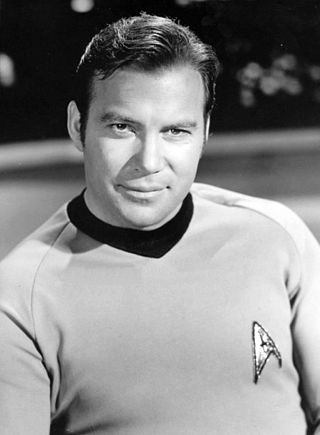
Star Trek II: The Wrath of Khan is a 1982 American science fiction film directed by Nicholas Meyer and based on the television series Star Trek. It is the second film in the Star Trek film series following Star Trek: The Motion Picture (1979), and is a sequel to the television episode "Space Seed" (1967). The plot features Admiral James T. Kirk and the crew of the starship USS Enterprise facing off against the genetically engineered tyrant Khan Noonien Singh. When Khan escapes from a 15-year exile to exact revenge on Kirk, the crew of the Enterprise must stop him from acquiring a powerful terraforming device named Genesis. The film is the beginning of a three-film story arc that continues with the film Star Trek III: The Search for Spock (1984) and concludes with the film Star Trek IV: The Voyage Home (1986).

James Tiberius Kirk, commonly known as James T. Kirk or Captain Kirk, is a fictional character in the Star Trek media franchise. Originally played by Canadian actor William Shatner, Kirk first appeared in Star Trek serving aboard the starship USS Enterprise as captain. Kirk leads his crew as they explore new worlds, new civilizations, and "boldly go where no man has gone before". Often, the characters of Spock and Leonard "Bones" McCoy act as his logical and emotional sounding boards, respectively. Kirk has also been portrayed in numerous films, books, comics, webisodes, and video games.

Leonard Simon Nimoy was an American actor and director, famed for playing Spock in the Star Trek franchise for almost 50 years. This includes originating Spock in the original Star Trek series in 1966, then Star Trek: The Animated Series, the first six Star Trek films, Star Trek: The Next Generation, Star Trek (Film), and Star Trek Into Darkness. Nimoy also directed films, including Star Trek III: The Search for Spock (1984), Star Trek IV: The Voyage Home (1986), and Three Men and a Baby (1987), and appeared in several films, television shows, and voice acted in several video games. Outside of acting, Nimoy was a film director, photographer, author, singer, and songwriter.

Spock is a fictional character in the Star Trek media franchise. He first appeared in the original Star Trek series serving aboard the starship USS Enterprise as science officer and first officer and later as commanding officer of the vessel. Spock's mixed human–Vulcan heritage serves as an important plot element in many of the character's appearances. Along with Captain James T. Kirk and Dr. Leonard "Bones" McCoy, he is one of the three central characters in the original Star Trek series and its films. After retiring from active duty in Starfleet, Spock served as a Federation ambassador, and later became involved in the ill-fated attempt to save Romulus from a supernova, leading him to live out the rest of his life in a parallel universe.

Star Trek: Phase II was the initial working title for what officially became titled Star Trek II, an unproduced American science fiction television series created by Gene Roddenberry as a sequel to the original Star Trek, which had run from 1966 to 1969. The plans for the series were first developed after several failed attempts to create a feature film based on the property, coupled with plans for a Paramount Television Service (PTS) as a fourth broadcast television network in the United States.

James Montgomery Doohan was a Canadian actor and author, best known for his role as Montgomery "Scotty" Scott in the television and film series Star Trek. Doohan's characterization of the Scottish chief engineer of the Starship Enterprise has become one of the most recognizable elements in the Star Trek franchise, and inspired many fans to pursue careers in engineering and other technical fields. He also made contributions behind the scenes, such as the initial development of the Klingon and Vulcan languages.

Star Trek IV: The Voyage Home is a 1986 American science fiction film, the fourth installment in the Star Trek film franchise based on the television series Star Trek. The second film directed by Leonard Nimoy, it completes the story arc begun in Star Trek II: The Wrath of Khan (1982), and continued in Star Trek III: The Search for Spock (1984). Intent on returning home to Earth to face trial for their actions in the previous film, the former crew of the USS Enterprise finds the planet in grave danger from an alien probe attempting to contact now-extinct humpback whales. The crew travel to Earth's past to find whales who can answer the probe's call.

Star Trek V: The Final Frontier is a 1989 American science fiction film directed by William Shatner and based on the television series Star Trek created by Gene Roddenberry. It is the fifth installment in the Star Trek film series, and takes place shortly after the events of Star Trek IV: The Voyage Home (1986). Its plot follows the crew of the USS Enterprise-A as they confront renegade Vulcan Sybok, who is searching for God at the center of the galaxy.

Star Trek III: The Search for Spock is a 1984 American science fiction film, written and produced by Harve Bennett, directed by Leonard Nimoy, and based on the television series Star Trek. It is the third film in the Star Trek franchise and is the second part of a three-film story arc that begins with Star Trek II: The Wrath of Khan (1982) and concludes with Star Trek IV: The Voyage Home (1986). After the death of Spock (Nimoy), the crew of the USS Enterprise return to Earth. When James T. Kirk learns that Spock's spirit, or katra, is held in the mind of Dr. Leonard "Bones" McCoy, Kirk and company steal the decommissioned USS Enterprise to return Spock's body to his homeworld. The crew must also contend with hostile Klingons, led by Kruge, who are bent on stealing the secrets of the powerful terraforming device, Genesis.

Christine Chapel is a fictional character who appears in all three seasons of the American science fiction television series Star Trek: The Original Series, as well as Star Trek: The Animated Series and the films Star Trek: The Motion Picture and Star Trek IV: The Voyage Home. Portrayed by Majel Barrett, she was the ship's nurse on board the Starfleet starship USS Enterprise. A younger version of Chapel appears in the 2022 series Star Trek: Strange New Worlds, portrayed by Jess Bush.

Robin Curtis is an American actress. She is best known for replacing Kirstie Alley in the role of Vulcan Lieutenant Saavik in the films Star Trek III: The Search for Spock and Star Trek IV: The Voyage Home.

Lucie Désirée Arnaz is an American actress and singer. She is the daughter of actors Lucille Ball and Desi Arnaz.

Whose Life Is It Anyway? is a play by Brian Clark adapted from his 1972 television play of the same title, which starred Ian McShane. The stage version premiered in 1978 at the Mermaid Theatre in London, and subsequently opened on Broadway in 1979. The play involves a sculptor who is paralysed.

Zachary John Quinto is an American actor and film producer. He is known for his roles as Sylar, the primary antagonist from the science fiction drama series Heroes (2006–2010); Spock in the film Star Trek (2009) and its sequels Star Trek Into Darkness (2013) and Star Trek Beyond (2016); Charlie Manx in the AMC series NOS4A2, and Dr. Oliver Thredson in American Horror Story: Asylum, for which he received a nomination for an Emmy award. His other starring film roles include Margin Call (2011), Hitman: Agent 47 (2015), Snowden (2016), and Hotel Artemis (2018). He also appeared in smaller roles on television series, such as So Notorious, The Slap, and 24, and on stage in Angels in America, The Glass Menagerie, and Smokefall.

Beverly Joanne Linville was an American actress. She later taught at the Stella Adler Academy, Los Angeles. Linville guest-starred as a Romulan Commander on Star Trek: The Original Series.

William Shatner is a Canadian actor. In a career spanning seven decades, he is best known for his portrayal of James T. Kirk in the Star Trek franchise, from his 1966 debut as the captain of the starship Enterprise in the second pilot of the first Star Trek television series to his final appearance as Captain Kirk in the seventh Star Trek feature film, Star Trek Generations (1994).

"The Last Voyage of the Starship Enterprise" is a comedy sketch that first aired on May 29, 1976, during episode 22 of the first season of the NBC variety show, Saturday Night Live. The twelve-minute sketch was written by Michael O'Donoghue during a month-long process consulting with actor John Belushi. The sketch is a satire of the 1969 cancellation of Star Trek. The set design featured an effective replica of the bridge of the USS Enterprise. Dress rehearsal was difficult, with the writer doubting whether Belushi was able to pull off an effective parody of William Shatner's performance as Captain James Kirk. However, the result was a success, and O'Donoghue immediately congratulated Belushi after his performance and reflected that he had perfectly parodied Shatner as Kirk.

Mind Meld: Secrets Behind the Voyage of a Lifetime is a 2001 American documentary film in which actors William Shatner and Leonard Nimoy discuss the Star Trek science fiction franchise and its effects on their lives. Shatner and Nimoy portrayed the characters James T. Kirk and Spock respectively in the 1960s Star Trek television series, the 1970s animated television series, and their film sequels.

The development of Spock, a fictional character first introduced in the American science fiction television series Star Trek, began prior to the start of the series. The first known mention of Spock was in a discussion between Gene Roddenberry and Gary Lockwood, where the latter suggested Leonard Nimoy for the role. Roddenberry agreed with the suggestion, and Nimoy became the first choice actor for the part. However, Roddenberry was required to audition other actors for the role. It was offered to both DeForest Kelley and Martin Landau before Nimoy. Nimoy disliked the prosthetic ears he was required to wear, and there were concerns from the studio that they made him appear satanic. Roddenberry fought to keep the character in the second pilot, "Where No Man Has Gone Before" after the rest of the main cast was dropped from the initial pilot, "The Cage".



















